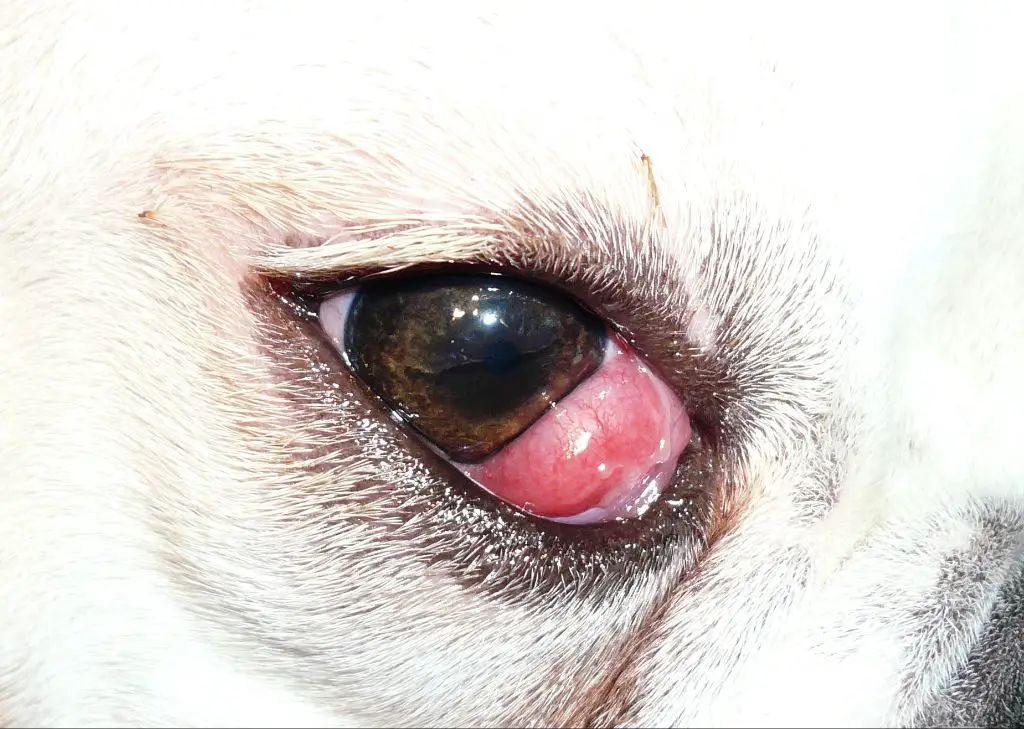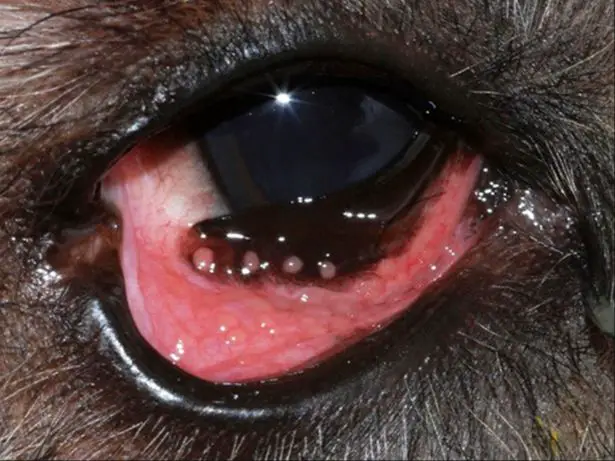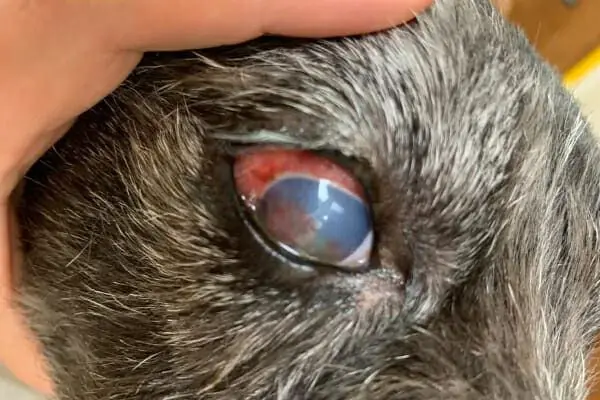Introduction
A dog’s eye that appears red and is looking sideways is often a sign of an underlying health issue. While it may seem harmless at first, a red sideways-looking eye should not be ignored. Left untreated, many of the potential causes can lead to discomfort, pain, and even vision loss for your dog. That’s why it’s important to understand some of the possible reasons for this condition and what you can do about it.
Possible Causes
There are several possible reasons why your dog’s eye may appear red and looking sideways, including:
Cherry Eye
Cherry eye is a condition where the third eyelid, which is usually hidden under the lower eyelid, protrudes and looks like a red mass in the corner of the eye. It is more common in certain breeds like Cocker Spaniels, Beagles, Pekingese, and Bulldogs. Cherry eye results from a weakening of the ligaments holding the third eyelid in place, causing it to protrude out. It usually affects younger dogs under the age of 2 years old.

Conjunctivitis
Conjunctivitis, also known as “pink eye,” is an inflammation of the conjunctiva, which is the thin membrane covering the white part of the eye. It can cause redness, discharge, swelling, and itchiness. Conjunctivitis can be caused by bacteria, viruses, allergies, and irritants like dust or chemicals. It is highly contagious between dogs.
Glaucoma
Glaucoma is a group of eye diseases characterized by increased pressure within the eye, which damages the optic nerve over time. One of the early symptoms can be a reddish or cloudy appearance to the eye. Glaucoma is more common in certain breeds like Basset Hounds, Cocker Spaniels, and Samoyeds. If left untreated, glaucoma can lead to blindness.
Infections
Eye infections caused by bacteria, viruses, or fungi can result in red, swollen, watery, or crusty eyes. Common eye infections in dogs include canine herpesvirus, adenovirus, and distemper. Eye infections need veterinary treatment as they can rapidly worsen if not treated.
Injuries
Injuries to the eye area, such as scratches, foreign objects, or trauma from a dog fight, can cause redness, pain, and abnormal positioning of the eye. It’s important to have eye injuries evaluated by a vet as soon as possible to avoid long-term damage.
Cherry Eye
Cherry eye is a condition where the gland of the third eyelid prolapses and protrudes as a red mass in the corner of the dog’s eye. It occurs most commonly in young dogs under 2 years old, especially breeds like Beagles, Bulldogs, Boston Terriers, Cocker Spaniels, and Shih Tzus. Cherry eye results from weakening of the ligaments that hold the third eyelid gland in place, causing it to swell and bulge out.
Symptoms of cherry eye include:
- Red, round protrusion in the corner of the eye
- Excessive tear production
- Irritation and inflammation of the eye
- Discomfort and pawing at the eye
Cherry eye is typically treated surgically by removing the gland of the third eyelid. This prevents irritation and damage to the eye. The surgery is minimally invasive and has a high success rate. Some vets may recommend anti-inflammatory eye drops before surgery to reduce swelling. After surgery, dogs usually recover within a few days with minimal complications. Prompt treatment is important to avoid permanent damage and vision problems.
Conjunctivitis
Conjunctivitis, also known as pink eye, is inflammation of the conjunctiva, which is the thin transparent tissue that lines the inner eyelid and covers the white part of the eye. It can affect one or both eyes. The conjunctiva contains many small blood vessels that can become swollen during an infection, causing the whites of the eyes to appear red or pink.

Symptoms
Common symptoms of conjunctivitis include:
- Redness in the white of the eye
- Watery discharge that can sometimes stick the eyelids together
- Gritty feeling in the eyes
- Itching and burning sensation
- Mild eye pain or soreness
Treatment
Treatment depends on the cause. Viral and bacterial conjunctivitis often clears up on its own without treatment within 1-2 weeks. Your vet may recommend antibiotic eye drops or ointments for bacterial infections. Antihistamine eye drops can provide relief for allergic conjunctivitis. Make sure to finish the full course of any prescribed medication, even if the symptoms go away sooner.
Prevention
You can help prevent conjunctivitis by:
- Washing hands before and after touching the eyes
- Using separate towels and washcloths for infected eyes
- Not sharing eye makeup or eye drops
- Disinfecting surfaces the dog contacts
- Treating eye infections promptly to prevent spreading
Glaucoma
Glaucoma is a group of eye conditions that damage the optic nerve, which is vital for good vision. This damage is often caused by an abnormally high pressure in the eye.
There are two main types of glaucoma:

- Open-angle glaucoma: This is the most common form. It develops slowly over time and there are no symptoms at first. The increased eye pressure is gradual, so the optic nerve becomes damaged before the person notices any vision loss.
- Angle-closure glaucoma: This is less common but it develops suddenly and is a medical emergency. There is a rapid, severe increase in eye pressure that causes optic nerve damage and rapid vision loss if not treated quickly.
Risk factors for glaucoma include:
- Increased eye pressure (intraocular pressure)
- Older age
- Family history
- Farsightedness
- Past eye injury
- Thin corneas
- Certain medications like steroids
Symptoms of open-angle glaucoma include:
- Gradual loss of peripheral vision
- Blind spots developing in vision
- Trouble seeing in dim light
Symptoms of angle-closure glaucoma include:
- Sudden, severe pain in one eye and possibly a headache
- Nausea and vomiting
- Sudden visual disturbances like halos around lights
- Redness in the eye
- Dilated pupil in the affected eye
- Vision loss
To diagnose glaucoma, an ophthalmologist will perform a comprehensive eye exam and measure your eye pressure. Other tests like imaging scans or visual field testing may also be done to evaluate optic nerve damage and vision loss patterns.
Treatment depends on the type and severity of glaucoma. It aims to lower eye pressure through prescription eyedrops, laser or surgery procedures, or medications. Early treatment is key to preventing vision loss.
It’s crucial to get regular eye exams since glaucoma causes no early symptoms. Ongoing treatment and monitoring are needed to manage glaucoma and protect vision.
Infections
Dogs can develop several types of eye infections that may cause red, irritated eyes or eyes looking sideways. Some of the most common eye infections in dogs include:
Conjunctivitis
Conjunctivitis is inflammation of the conjunctiva, the thin transparent tissue that covers the inner eyelid and front of the eye. It is often called “pink eye.” Conjunctivitis has numerous possible causes including bacteria, viruses, allergies, and irritants. Symptoms include redness, discharge, itching, and crusty eyes. It can affect one or both eyes. Treatment depends on the cause but may include eye drops, ointments, compresses, antihistamines, and antibiotics.
Keratoconjunctivitis Sicca
Also known as “dry eye,” keratoconjunctivitis sicca is caused by inadequate tear production. Symptoms include redness, discharge, pain, squinting, and corneal scarring. It is commonly treated with cyclosporine eye drops to stimulate tear production, as well as eye lubricants. Severe cases may require surgery.
Bacterial and Viral Infections
Bacteria such as Staphylococcus, Streptococcus, and Pseudomonas can cause eye infections in dogs, leading to irritation, redness, discharge, and eye pain. Viruses like canine herpesvirus, canine distemper, and canine adenovirus can also infect the eye. Bacterial infections are treated with antibiotic eye drops or ointment. Viral infections may require antiviral medication.
Keeping your dog’s eyes clean and avoiding contact with infecting agents can help prevent eye infections. See your vet at the first sign of eye redness, discharge, or discomfort.
Injuries
Dogs can suffer eye injuries from foreign objects, scratches, bumps, bites, and more. Some common eye injuries in dogs include:

- Corneal abrasions – Scratches on the surface of the eye caused by contact with foreign objects like sticks or tall grasses.
- Corneal ulcers – Open sores on the eye’s surface caused by deeper scratches that fail to heal.
- Eyelid lacerations – Cuts or tears to the eyelid from sharp objects, bites, etc.
- Conjunctivitis – Inflammation of the conjunctiva (pink tissue around eyes).
Symptoms of an eye injury may include excessive blinking, squinting, redness, swelling, discharge or tearing. More severe injuries may show impairment or loss of vision.
Treatment depends on the type and severity of injury. Minor scratches may just require flushing the eye and applying antibiotic ointment. Deeper injuries like corneal ulcers need prescription antibiotic or anti-inflammatory eye medications. Eyelid lacerations may require stitches and antibiotics. Prevention involves being alert on walks, avoiding thin leashes that could snap into the eye, and keeping foreign objects away from the face.
When to See the Vet
If your dog’s eye appears red and they are squinting or looking sideways, it’s important to have them seen by a veterinarian as soon as possible. Here are some red flags and emergency symptoms that warrant an urgent vet visit:
Sudden onset – If the red eye and squinting comes on suddenly without any apparent cause, this could signal a serious issue like glaucoma or acute injury, which requires rapid treatment. Don’t wait to see if it improves on its own.
Eye discharge – Any type of discharge or weeping from the eye, especially if thick, green, or yellow, indicates infection or inflammation. This calls for prompt veterinary attention.
Rubbing or pawing at the eye – If your dog is excessively rubbing or scratching at their eye, they’re likely in pain or discomfort. Have them seen right away.
Swelling or bulging of the eye – Any abnormal swelling or bulging of the eyeball itself is an emergency. This can signal glaucoma, infection, or possibly even a tumor behind the eye. Don’t delay seeking veterinary assessment.
Trauma or injury – If your dog has suffered any type of trauma to the eye, such as a scratch or puncture, visit the vet as soon as possible to prevent infection and further damage.
Bottom line – when in doubt, contact your veterinarian. A red, squinting eye could quickly escalate to vision loss or permanent damage if left untreated. It’s always better to err on the side of caution when it comes to your dog’s precious eyesight.
At-home Care
When a dog has a red, sideways-looking eye, there are some at-home remedies pet owners can try while monitoring the condition:
Cleaning
Gently flush the eye with an eyewash to remove any irritants or debris. Use a sterile saline solution or plain water, applying it to the eye with a clean cotton ball. Be very gentle and avoid rubbing the eye.
Medications
If the vet has prescribed antibiotic eye drops or ointments, be sure to administer them as directed. This will help clear up any infection causing inflammation or irritation.
Home Remedies
Applying a cool compress with a damp towel or cloth can help soothe inflammation and provide comfort. Limit eye rubbing by putting an Elizabethan collar on the dog. Keep the dog’s face and eyes clean and dry to prevent worsening of symptoms.
While at-home care can provide relief, it’s important to follow up with the vet if symptoms persist or get worse. Some conditions like glaucoma can progressed rapidly and cause permanent damage if left untreated.
Prevention Tips
There are several ways pet owners can help prevent eye issues in dogs:
- Keep the eyes clean by gently wiping away any discharge daily with a soft, damp cloth. Avoid using cotton swabs or anything abrasive.
- Trim hair around the eyes regularly so it doesn’t poke or scratch the eyes.
- Make sure your dog gets eye drops prescribed by your vet if they have chronic eye conditions.
- Feed your dog a nutritious diet rich in vitamins A, C, and E to support eye health.
- Don’t allow your dog to stick their head out the window when driving, as dust and debris can damage the eyes.
- Use goggles or doggy eye shields when bathing your dog to keep shampoo and water out.
- Avoid exposing your dog to secondhand smoke, as this can irritate the eyes.
- Use flea and tick prevention medications as parasites can infect the eyes.